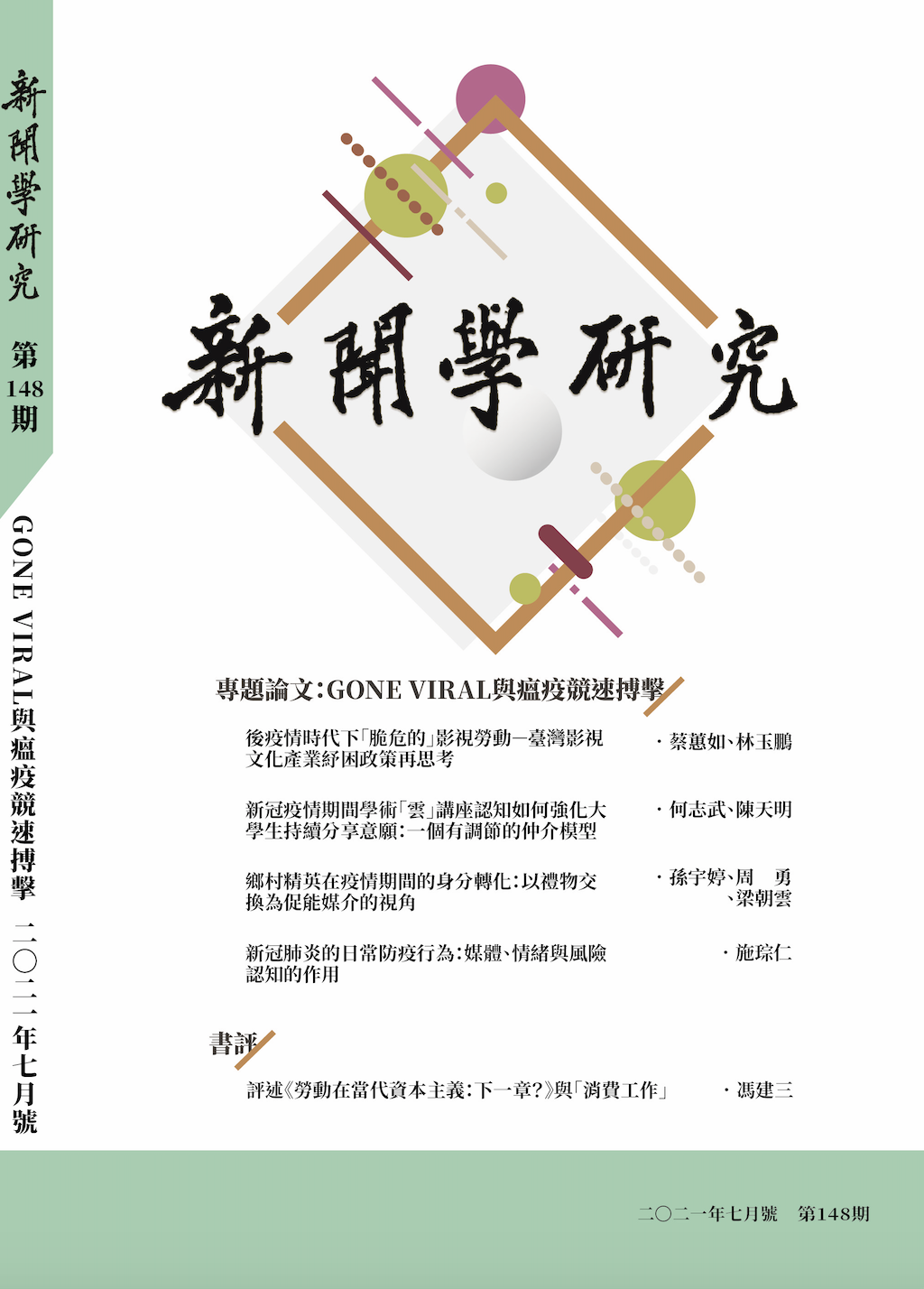前期出版
前期出版
頁數:153﹣196
新冠肺炎的日常防疫行為: 媒體、情緒與風險認知的作用
Preventive Measures as a New Lifestyle During and After COVID-19: The Interplay of Media, Emotions, and Risk Perception
專題論文
作者(中)
施琮仁
作者(英)
Tsung-Jen Shih
關鍵詞(中)
日常防疫行為、社群媒體使用、風險認知、恐懼、新冠肺炎
關鍵詞(英)
COVID-19, fear, preventive measures, risk perception, social media use
中文摘要
新型冠狀病毒在全世界造成嚴重疫情,自首例確診迄今已逾一年半,防疫行為可能不只是短期內民眾必要的自我防護措施,更是長期必須習慣的新生活方式。本研究結合風險理論與媒體效果理論,試圖理解影響民眾在日常生活中採取防疫行為的因素。根據全國電話調查資料(N = 1,073),臺灣民眾在疫情期間的生活方式和過去有明顯的不同,有超過八成的民眾戴口罩的次數比平常頻繁(82.9%)、也更常洗手(83.1%);六成以上的民眾(63.6%)除了上學、上班,出門的次數較過去為少。
迴歸分析結果發現,民眾對自身受到感染的可能性評估和是否採取因應行為無關,但對於疫情的恐懼感,卻能促發其採取行動。此結果顯示,情緒對於人類行為的驅動比認知有效。本研究亦發現電視具有風險放大效果,風險認知和恐懼的關係,對於經常從電視獲取疫情訊息的民眾而言較為強烈,而風險認知和日常防疫行為的關係,卻對低度社群媒體使用者來說較為顯著,意味著媒體的放大或縮小效果不僅出現在民眾的風險認知過程中,也出現在後續對情緒、行為的影響路徑上,擴大了風險社會放大理論的應用範圍。
迴歸分析結果發現,民眾對自身受到感染的可能性評估和是否採取因應行為無關,但對於疫情的恐懼感,卻能促發其採取行動。此結果顯示,情緒對於人類行為的驅動比認知有效。本研究亦發現電視具有風險放大效果,風險認知和恐懼的關係,對於經常從電視獲取疫情訊息的民眾而言較為強烈,而風險認知和日常防疫行為的關係,卻對低度社群媒體使用者來說較為顯著,意味著媒體的放大或縮小效果不僅出現在民眾的風險認知過程中,也出現在後續對情緒、行為的影響路徑上,擴大了風險社會放大理論的應用範圍。
英文摘要
The COVID-19 pandemic seriously struck the world in early 2020 and has exerted great impacts on every aspect of human life. Whether the disease can be contained or not depends greatly on how well people take preventive measures over an extended period of time. This study thus integrates theories from risk communication and media effects to understand the predictors of preventive measures, with a specific focus on the interplay among media, risk perception, and emotion. Based on a representative, dual-frame telephone survey (N = 1,073), the current study finds that people’s ways of living have changed quite drastically during the pandemic. More than 8 out of 10 Taiwanese expressed wearing face masks (82.9%) and washing hands (83.1%) more frequently than the usual level, while 63.6% of people indicated that they have tried to avoid going out, unless it is necessary, such as going to work or school. More than one-third of Taiwanese had canceled a planned trip (35.7%) and about a quarter are considering to do so (23.0%).
Results of regression analyses suggest that risk perception is not directly predictive of people’s preventive behaviors, but it does positively affect behaviors by increasing people’s level of fear, lending support to the “emotion mediation model.” The results also indicate an amplifying effect of television on the relationship between risk perception and fear. Conversely, social media use exerts an attenuating effect that mitigates the impact of risk perception on preventive behaviors. The results extend the applicability of the social amplification of the risk framework from risk perception to subsequent emotional and behavioral responses. Further implications are discussed.
Results of regression analyses suggest that risk perception is not directly predictive of people’s preventive behaviors, but it does positively affect behaviors by increasing people’s level of fear, lending support to the “emotion mediation model.” The results also indicate an amplifying effect of television on the relationship between risk perception and fear. Conversely, social media use exerts an attenuating effect that mitigates the impact of risk perception on preventive behaviors. The results extend the applicability of the social amplification of the risk framework from risk perception to subsequent emotional and behavioral responses. Further implications are discussed.
8887次下載



